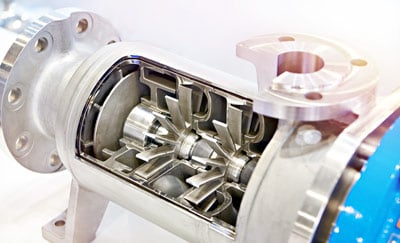Canned Motor vs. Magnetic Drive Pumps

Canned motors and magnetic drive pumps fall into the category of seal-less pumps. Seal-less pumps replace the conventional mechanical seal with a static containment shell. The advantage of such a system is that it ensures no fluid leakage. Hence, seal-less motors are the preferred choice when you need to pump fluids that should not leak out in the atmosphere.
In conventional pumps, the motor is connected to the impeller via a shaft. The mechanical seals between the two components ensure that the fluid in the impeller section doesn’t seep into the motor section. In contrast, seal-less pumps use alternative methods to achieve impeller rotation without a direct connection between impeller and motor.
Let’s find out the key differences between a canned motor and a magnetic drive pump.
Canned Motor vs. Magnetic Drive Pumps
The primary difference between these two types of pumps is how the impeller rotates–more specifically–what type of force causes the impeller to spin.
Drive
 As the name suggests, the impeller rotates in a magnetic drive pump due to the attractive and repulsive forces of permanent magnets installed within the pump. When the driveshaft from the motor turns a set of magnets, the magnets on the impeller side also begin to rotate from the opposing force applied by the motor side magnetics.
As the name suggests, the impeller rotates in a magnetic drive pump due to the attractive and repulsive forces of permanent magnets installed within the pump. When the driveshaft from the motor turns a set of magnets, the magnets on the impeller side also begin to rotate from the opposing force applied by the motor side magnetics.
In a canned motor, the drive is composed of a standard rotor and stator arrangement. When an alternating current passes through this stator, the resulting magnetic field turns the rotor. The rotor inside a canned motor is also completely sealed off from the stator, providing a leak-proof design.
Seal
Both types of pumps provide a hermetic seal between the fluid and drive sides. In addition, the design of these pumps allows for 100% leak-free operation.
Size
When it comes to the overall footprint of the pumps, canned motor pumps are much more compact. This is due to their rotor design which incorporates rotor winding and the impeller into one piece.
Pump Operating Point
The pump operating point or the duty point is an indicative point on the Q-H curve (Head vs. Flow). It is obtained by intersecting pump characteristics and piping system characteristics. The duty point indicates a point where the pump will deliver the best performance against the system requirements. A change of pump operating point means changing some characteristics of the pump like flow, head, the viscosity of the fluid, etc.
In magnetic driver pumps, changing the operating point is possible by modifying the motor specifications. However, the original operating point cannot be altered for canned motor pumps, and a new pump may be required.
Fluid Containment
Magnetic drive motors have a single containment zone. This means the fluid is contained in a single-walled can.
A canned motor pump, on the contrary, has double containment where the fluid is encased in a sealed can (stator liner), which in turn is encased in the pressure-proof motor casing. Hence, if the stator liner ruptures, the fluid will get safely contained in the motor casing.
Choose the Right Pump with Hayes
Choosing between canned motor pumps and magnetic drive pumps comes down to many factors. Not sure which pump would best meet your requirements? Connect with our team of experts to get expert assistance in the selection process.




